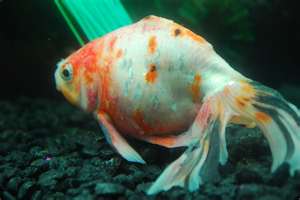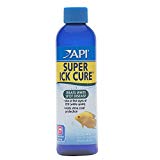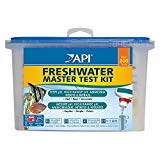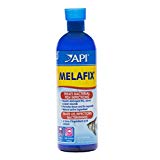If your goldfish is showing signs of distress, sickness, disease or parasite infection, try the least dangerous route first, making sure you’ve done everything possible for your goldfish before resorting to medications. Typically the root of the problem has to do with poor water quality, stemmed from goldfish overfeeding, improper goldfish water changes or inadequate filters or water surface action. Learn everything you can about goldfish care so that your fish will live a long and healthy life.
Follow the basic rules of good aquarium or pond management and your goldfish will rarely get sick. Provide adequate oxygen supply, keep their environment clean, make partial water changes as necessary and feed your fish correctly.
Unfortunately, goldfish diseases sometimes still occur and it’s important that you identify diseases and treat your sick goldfish as soon as possible. The first sign to be aware of is a stressed fish. Just as a stressed human is prone to infection by bio- aggressors, so are fish, and stress is the principal cause of disease in fish.
There are 3 basic types of diseases in fish: parasitic, bacterial and fungal. These organisms are always present in the aquatic environment and a healthy fish can generally ward them off, however, if a fish is weakened by stress or damage the risk of infection is high.
When goldfish are in distress, not feeling well, or dying, they can exhibit a variety of symptoms in various combinations. When goldfish are exhibiting these symptoms, try some home remedies and home care before seeking medications. The proper environment for goldfish is a complex ecosystem that must be perfectly balanced.
The most common maladies seen in home aquariums are either bacterial or parasitic in origin.
Fungal is sometimes seen and occasionally, physical ailments.
Table of Contents
Behavioral symptoms – things you might notice
Parasites
White Spot
Dropsy
Bacterial Infection
Ulcers
It’s all about catching symptoms early so correct treatment can be given and the fish can recover.
Behavioral Symptoms
When illness strikes your goldfish tank your fish may display behavioral symptoms such as:
- clamped fins
- body shaking
- repeated scratching against the objects in the tank
- gasping at the surface
- hiding in corners
- swimming abnormally
- breathing difficulties
- sitting on the bottom of the tank
- ragged fins with signs of infection
- open sores
- reddening of the skin or fins.
Parasitic Goldfish Illness
Diseases associated with parasites are usually caused by bad water conditions or stress.
The most common parasitic disease is goldfish ich. This illness can be deadly if it’s not treated and the fish will seem extremely irritated and they’ll usually rub against the side of the fish tank.
White Spot on Fish (Ich)
White Spots are caused by parasites infecting the goldfish.
The signs to watch for are small white spots on the skin, fins, and gills. The spots are about the size of a grain of sugar. It’s caused by stress related issues such as poor, incorrect water conditions, unstable water temperature and general poor husbandry. Sensitive goldfish may develop white spots as a result of being introduced to a new aquarium.
The eyes can become cloudy and they can have difficulty breathing. Physically the goldfish will have white spots all over. Some people say it looks like the goldfish has been sprinkled with salt.
The entire tank will need to be treated to kill the parasite. Adding aquarium salt to the water may also kill the parasite.
Treatment: Ensure the water is free of pollution and isolate the cause of stress. Treat promptly with an anti-parasite medication. 2 treatment options are Malachite Green treatment or API’s Super Ick Cure.
These are some of the most effective treatments and a water test kit to help you diagnose the problem
Dropsy
This is dangerous in goldfish and isn’t a goldfish illness, but a symptom. It can be caused by a number of issues including bacterial, viral or parasitic infections, environmental, nutritional and metabolic problems.
Symptoms are swelling of the body cavity due to a build-up of fluid. The scales on the goldfish will also stick out. They can become raised giving a pinecone-like appearance. The goldfish may have swollen eyes and bloating.
Poor water quality, particularly the presence of ammonia and nitrates can aggravate the problem.
It’s important to isolate the sick goldfish to prevent disease spreading to other fish.
Treatment: Test and improve water conditions immediately by adding aquarium salt at a dose of 2 to 3 grams per liter to prevent the salt loss.
Note: Dropsy is hard to treat, can be fatal and it commonly leads to kidney failure. It requires the use of a broad spectrum anti-bacterial treatment.
One product I like is Tetra AquaSafe Water Conditioner with BioExtract.
The goldfish should be isolated in a very warm temperature tank. Salt can be added to the water. If the goldfish is eating, there’s special food they need to eat. If the goldfish is not eating, there are injections available to help try to get the goldfish healthy again.
Bacterial Infections
These cover a variety of common goldfish illnesses. Tail, fin rot and ulcers are examples.
Symptoms of bacterial infections are:
- ragged fins
- white or open red sores
- bulging eyes
- reddish tint to the skin
Open sores can be washed with peroxide and an antibiotic ointment should then be applied.
Ulcers
These are caused by pseudomonas and aeromonas bacteria.
Symptoms are pinky-white open wounds and sometimes the fish has secondary infections caused by fungi and other bacteria.
Generally caused by very poor water quality especially the presence of ammonia and nitrates and excessively high PH levels. It mostly affects newly imported goldfish.
Wounds can also occur as a result of fighting or poor handling when transporting the goldfish.
Goldfish Ulcer Treatment: Test if the water has ammonia and nitrates. Change the water to reduce the pollution level. Goldfish lose a lot of salt quickly through their open wounds, so add salt to the aquarium at a rate of 2 to 3 grams per liter along with an anti-ulcer treatment.
There are many other diseases that can affect your fish. Poor water conditions and improper handling of the fish contribute greatly to goldfish illness. Early detection of symptoms and implementing the appropriate treatment is the most important thing you can do to provide the best outcome for your fish.
Diagnosis of the illness affecting your fish is an important part of overall goldfish care.
It’s never good when goldfish begin acting differently and showing signs they might be sick. It can be hard to work out exactly what’s causing the sick fish to act in a particular way. If you’re aware of symptoms associated with the most common diseases and infections it makes diagnosis easier.
Although some symptoms may be signs of different problems, understanding what to look helps to catch and treat an illness before it’s too late.





